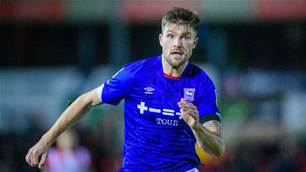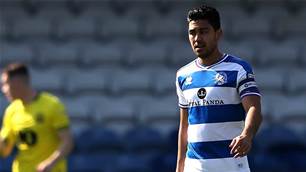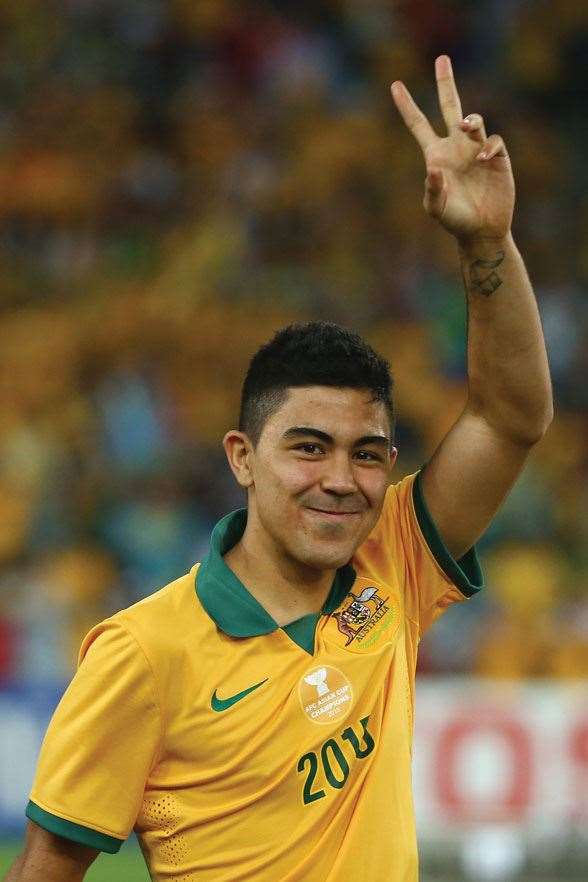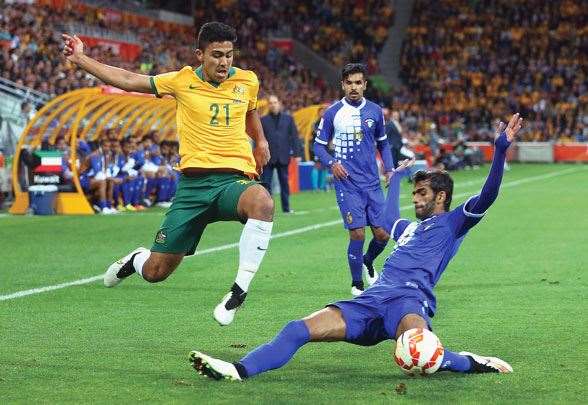From former Sydney schoolboy to Socceroos superstar.
It was a cold London night at Millwall’s home ground in March 2014. Australia had stunned Ecuador in the first half at The Den, racing to a 3-0 lead on the back of bold pressing and dynamic play under new coach Ange Postecoglou. But in the second half things fell apart, as the South Americans pulled one goal back, and then a second after goalkeeper Mitch Langerak was red-carded. On 76 minutes Ecuador equalised and the rookie Socceroos wilted. On came a 21-year-old substitute from League One’s Swindon Town. A thinly built, baby-faced midfielder, he had little time to make much of an impact in his brief cameo; Ecuador grabbed a heart-breaking winner in injury time and the Socceroos went down 4-3. It was a friendly game the green and gold shouldn’t have lost, but one that will be remembered for something else in the long run – the international arrival of Massimo Luongo. “I didn’t know what to expect,” the young star recalls. “Coming from League One, I just thought to play my normal game. I got on the ball and found I had a lot more time and could do a bit more. It was a surprise that I fitted in so well.”
When the Socceroos kicked off the Asian Cup on home soil in January ten months later, the Australian public was unsure what would happen next. The national team had exited the World Cup with three-straight losses and results heading into the tournament had hardly been eye-catching. Defeats to Belgium and Japan, combined with one-goal wins over Saudi Arabia and Qatar, showed that this was still a team under reconstruction. Postecoglou was experimenting and testing new players, desperately trying to find the right group to carry out his aggressive game plan. Some were tipping the Socceroos as favourites for the Asian Cup, but no one really knew what this young squad would produce when it mattered.
One of Postecoglou’s new charges was a 176cm-tall midfielder from Redfern, who had made his debut before the World Cup, but had received no game time in Brazil. Luongo had been given 30 minutes off the bench against the Belgians and then 76 against Saudi Arabia in London, the city he knew so well. It was that evening at Craven Cottage that most Australians got their first proper glimpse of “Mass”. Starting in a three-man midfield, he was impressive and confident. Linking well between defence and attack, this chef’s son immediately looked liked he belonged, belying his youth and inexperience. The international stage suited him down to the ground.
Against Qatar and Japan, Luongo again looked mature beyond his years. In the first half in Osaka, the Socceroos were eye-catching, taking the game to the Samurai Blue. Luongo was again in the middle of everything – winning the ball, dribbling out of trouble and hitting team-mates with his accurate passing. So when Australia met Kuwait two months later, in the Asian Cup opener at AAMI Park, expectations were mixed on which Socceroos would turn up – the ones who had destroyed Ecuador and out-played Japan in the first half, or the team that self-destructed against both opponents.
They got their answer quickly. The Socceroos were nervy in the opening stages; just eight minutes in, Hussain Fadhel bundled in the ball after a defensive mistake: 1-0 to Kuwait. The tension grew. A first-game loss to a weak opponent in a tournament on home soil would be an unmitigated disaster. Luongo, along with the others, looked as though the pressure of the occasion was getting to him. Possession was given away cheaply; simple errors crept into the Socceroos’ game.
Then, in a 12-minute spell, it all changed. From a throw-in, Luongo somehow wriggled past three Kuwaiti defenders. He reached the byline and cut the ball back perfectly to the feet of Tim Cahill, who struck it home: 1-1. On the stroke of half-time, Australia had the lead as Swindon’s athletic Antipodean struck again. Ivan Franjic swung in a cross from the right flank, and Luongo leapt, in a Cahill-esque manner, to powerfully nod the ball past the Kuwait ’keeper. First goal-creator, then goal-scorer. The Socceroos’ Asian Cup assault was underway, culminating in an historic night in Sydney against South Korea. And the beautiful game had a new local hero.
“My dad loved football. He wasn’t any good at it, but he loved it, obviously, coming from Italy. So he got me involved as soon as he could. I don’t think they wanted me to get hurt playing rugby.” To understand Massimo Corey Luongo, you have to understand his past, his background and the influence of his parents. Massimo’s father, Mario, hails from Ascoli in central Italy while his mother, Ira, comes from Indonesia and is the daughter of a Sultan. His parents met in Sydney and started a family in Redfern. With an older brother and sister, third child Massimo grew up in a family with strong cultural links to football. His first club was Queens Park FC, in Sydney’s eastern suburbs, where he would attend high school at Waverley College. In school and sport, young Massimo followed the path set by his brother Tiziano, who was a talented junior footballer.
It was as a teenager, at St George FC’s fourth-string Under-14s, that Luongo would meet the man who would change his life. David Magrone, now head of recruitment at English Championship side Queens Park Rangers, remembers the day well. “I was watching from the grandstand one day, this 13-year-old. He grabbed the ball deep in midfield and just headed in a straight line towards the attacking goal. He didn’t make any movements, but I noticed this body-swerve about him, and he kept his balance. I thought, ‘Woah, this kid ... ’ He was pretty lumpy at the time as well.”
Magrone’s interest was piqued. When he set up his own private academy the following year, Luongo was one of his pupils. For the next four years the pair, along with a group of fellow hopefuls, would train morning and night. It was an exhaustive schedule that began with a session at 5.45am before school and another 90-minute stint from 6pm. Day after day. Magrone explains his method: “I’m sure some of them would’ve walked in half asleep and maybe a bit sore in their body, and maybe the sports scientists, if we had any at the time, would’ve recommended rest days. But I didn’t want that; I didn’t want the sports scientists to dictate how many times we could train, because I knew if we didn’t train that day, there was another player in Europe training, learning and getting better. And that was the philosophy – if you want to be a top player, you have to focus.”
When coach Magrone shifted from St George to APIA Leichhardt, Luongo followed, the bond between the two growing stronger. Magrone funded his own academy team, which travelled around Western Europe on playing tours. The likes of Sydney FC, the Australian Under-17s and Australian Schoolboys all came calling, interested in this dark-haired midfielder, but Magrone rebuffed them all. “There’s no way any of those three could’ve given him any better than what he was getting,” he remonstrates today. “No one ever remembers if you played for the Australian Under-17s. I wouldn’t have argued, but I knew the quality of coaching he was going to get with those three wasn’t going to be enough. This was really important to me and thankfully his father was supportive. Most other parents would’ve been dreaming for their kid to be wearing an Australian shirt at 17 years of age, so they could go on and tell all their family and friends how good he is.” At 16, Luongo was playing for APIA’s Under-20s team. Tony Raciti, president of the club, remembers Massimo as a very capable individual who seemed to always have a lot of time on the ball and who did well against seasoned professionals. “It was very rare in those days for a 16-year-old to play in the Under-20s,” Raciti says. “It helped and hardened him.”
For nearly four years Luongo slogged away morning and night in obscure parks, refining his skills and fine-tuning his game. Little by little he developed but it wasn’t without setbacks. He trialed for NSW’s Institute of Sport but was knocked back. “That was a hit in the face,” Luongo reflects. “But I just listened to him [Magrone], stuck with him and it got me this far.” Luongo acknowledges the “massive help” Magrone provided: “He’s brilliant as a coach. From 13, 14 to 17, I did it the long way. I wasn’t the best in my team or anywhere near Australian-standard. He did a lot for me in that three-year gap. Up until my Tottenham days he was always like that coach figure. We all looked up to him and listened to everything he said.”
The pair shares a unique bond that is more mentor/protege now than coach/player. Magrone helped orchestrate his dream move to English Premier League club Spurs and also served as his agent for a time. “When I got over to the UK the role changed,” Luongo explains. “He got me the trial at Tottenham and I did well. After that, he sort’ve just mentored me. If I needed anything or had any problems, he’d sort them out. If I needed someone to talk to, he’d be there. To this day I still ask him after the game what he thought. He’s been a massive influence on me.”
“Back then I was very naive. I didn’t expect it to be as tough as it was. For 60 minutes I thought I did okay. Now I look back and think I didn’t actually do anything. There’s a lot more I could’ve added if I was to do that all over again now. But it’s a stepping stone and I learned from it. It’s experience. It all adds up and you can use it further down the track.” In January 2011, with an Italian passport secured through his father, Luongo officially joined Tottenham’s academy with the likes of Harry Kane and Ryan Mason. Starting off in the Under-18s, he worked his way into the Under-21s, where he captained the star-studded youth side. In September that year he was given a chance to make his first-team debut in the third round of the League Cup. Spurs travelled north to meet Stoke City at the Britannia Stadium. After 70 minutes he was brought on as a substitute. The game went to penalties. At 7-6 in favour of Stoke, Luongo, five days short of his 19th birthday, bravely stepped up as Spurs’ eighth penalty taker. But his shot was saved and the north London club was knocked out of the competition. Harry Redknapp would not call on the young Aussie again. He sat on the bench two more times for the first team and was then shipped out on loan.
In July 2012 he joined Championship outfit Ipswich Town on loan for the 2012/2013 season. Luongo made 11 appearances, scoring his first senior professional goal for the Tractor Boys, but the deal was cut short in November that year. Ipswich boss Mick McCarthy needed “a different type of player”. Dropping another level, in March 2013 Luongo arrived at League One’s Swindon Town. But here, things began to fall into place. In just his fifth game for the Robins, he scored and claimed an assist, starring in central midfield in a 4-1 rout of Crewe Alexandria. He racked up nine appearances, helping Swindon Town into the playoffs, but was unable to stop them dropping out at the first stage. The club’s manager, Mark Cooper, had seen enough. In July 2013, Luongo was signed on a season-long loan. Eight weeks later, Swindon Town made the move permanent, paying Tottenham a fee of $860,000 for the Australian. Luongo was on his way.
Understandably, Luongo has no regrets about the path his career has taken. “I don’t regret leaving Tottenham. Everything’s gone well since I left Tottenham. I think I’ve made the right moves. Doors have opened at the Socceroos; Ange came and watched me at Swindon and he knew I was doing well. My move here got my name out there in League One.”
Over the next two seasons Luongo gained invaluable experience, playing every week and adjusting to the grind of English football. His development continued swiftly, his body became battle-hardened and his fitness improved. More and more admirers started to flock to Swindon’s County Ground as his reputation grew and grew. As alluded to by Luongo, one of those admirers was Postecoglou. Just five months into his Socceroos appointment, the 50-year-old gave Luongo his international introduction; 20 months after that fateful night at The Den, life has changed dramatically for young Mass.
“The Asian final was like a dream. In front of my home town, just a great moment for me and I still think about it. It was nice, it was nice for everyone watching, family and stuff. The Asian Cup sort of set me up. Everything in that tournament benefitted me, the formation, the amount of games in the short amount of time ... I wasn’t expecting too much of myself and that probably took the pressure off me a little bit. I just played my own game and it worked.”
Things have moved fast for Massimo Luongo in the last year and a half. He has gone from a little-known midfielder battling away in England’s lower leagues, to a continental champion, winner of the Asian Cup’s Most Valuable Player award and voted in the team of the tournament. He also got married and bought himself a dog. Those international performances, combined with his displays for Swindon, which saw him selected in the 2014-2015 PFA League One Team of the Year, have made him hot property.
Even with several Premier League sides such as Aston Villa chasing him, Luongo made a switch to Championship side Queens Park Rangers in May. With Chris Ramsey and Les Ferdinand running QPR, who had previously coached him in Tottenham’s youth teams, not to mention with Magrone on staff, it was a wise call. “QPR showed their interest in me [early] and I think that’s what attracted me to them. Obviously the managers at Villa and QPR I’ve had history with ... the chance of me playing was a lot bigger.”
Luongo has made a fast start to his Loftus Road career, starting every game and setting up several goals. He’s playing in a more advanced role than at Swindon, as a number-ten, but it’s a position he’s relishing. “It’s a bit of a different way of playing football, but I’m used to it. The Championship demands a bit more of a direct style at times, but I’ve adapted and I’ve found my feet pretty quickly. I’ve found myself playing up higher in the ten role; I’ve enjoyed it.”
The 23-year-old’s transfer to QPR, combined with his starring role in the Asian Cup triumph, means Luongo has quickly become one of the biggest names in Australian football. Alongside Cahill and new Valencia goalkeeper Mat Ryan, Luongo is the most marketable and recognisable face in the newly reformed national team. It’s a status dating back to the Asian Cup and has taken some getting used to. “After that first game in Melbourne, I was everywhere with the media attention,” Luongo admits. “I thought it would affect me, but it didn’t. I sort of used it and flourished from it, almost. But what did affect me was all the talk about moving clubs and how I needed to be at a bigger club to test myself. I knew that and I think everybody wants that. I didn’t have the best end to the season at Swindon. There were injuries, it was all stop-start, a lot of transfer rumours ... I think was just trying to do too much and that sort of affected me.”
Honest, forthright, grounded, Luongo is different to the media-trained modern footballer who speaks in cliches. He has an open demeanor that’s both refreshing and rare. A respectful, almost-shy individual, he is most happy relaxing at home with his new bride in their south London home. You won’t find him in the tabloids or in the city’s most famous nightclubs, or exploiting his newfound stardom. His one vice? His love of a good cappuccino. “Massimo takes it all in his stride,” Magrone says. “He’s so down-to-earth. He’s been brought up fantastically by his parents.”
After almost a decade of struggle and hard work, you could say Luongo has made it. After less than 20 international caps, he’s achieved more in terms of silverware than most Socceroos do in 70 or 80 appearances, but the midfielder is just getting started.
Luongo bats away compliments and is almost painfully modest: “Now I just forget about what’s happened in my past; I’ve still got to prove myself at this club again. The way I play is the way I play. I might not always be at the top of my game, but I’ll always try my best.”
Luongo is on a mission to get better, to prove he is no flash-in-the-pan and to get back into the Premier League. He’s already showed his versatility, switching from defensive midfield, to being a box-to-box player, to playing in the hole for club and country. Give Luongo a task and he’ll complete it. With his nous to create and score, defend and attack, dazzle and inspire, the Socceroos have found their man to replace Tim Cahill as the figurehead for the sport in this country. “He’s 23 and he’ll be in the game at the highest level for the next ten years at least,” Magrone predicts. “He’ll be the face of the game in Australia for a long time. I’ve got no doubt he’ll captain the Socceroos in a World Cup. He’s got so much more to offer.”
Related Articles

'Hell of a step up': Fairy-tale man Burgess relishing Tractor Boys EPL test

Socceroo Luongo retires ahead of Asian Cup
















